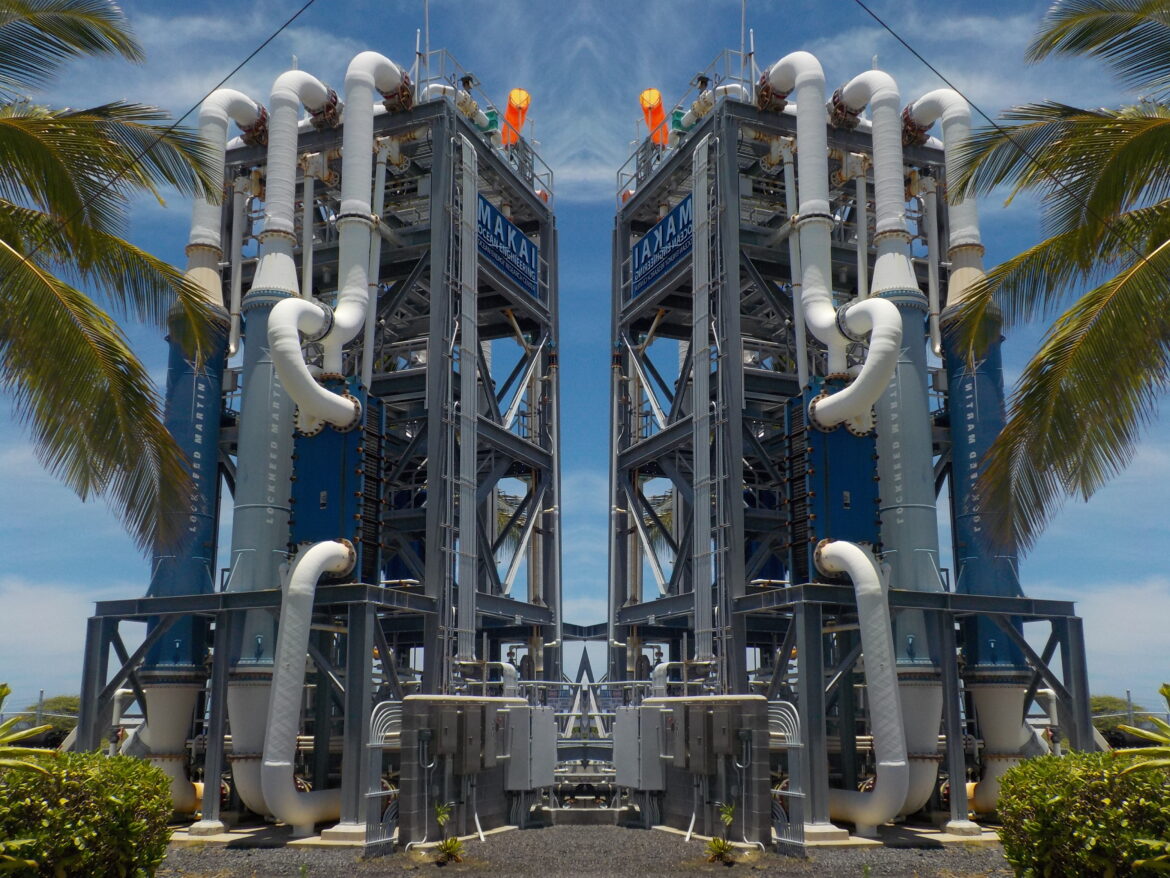Ocean Thermal Energy Conversion (OTEC) is a groundbreaking technology that refers to the process of producing energy by harnessing the temperature differences between ocean surface waters and deep ocean waters. This new source of energy production has the potential to produce significant amounts of continually available renewable energy, despite its feasibility only having been accessed by instances in which it was implemented on a small scale. As the technology is now being presented for wide-scale usage, an understanding of the ramifications of its implementation must be conjured before attempting to utilize OTEC as a new form of renewable energy.
The operation of the OTEC system requires a temperature difference of at least 20 Celsius to power a turbine to produce electricity. Warm surface waters (typically around 25℃) are pumped through an evaporator containing a working fluid, and cold deep ocean waters (typically around 5℃) are pumped from the depths of the ocean and used to condense the vaporized working fluid. The vaporized fluid then drives a turbine or generator. OTEC relies on the constant temperature difference between the ocean’s surface and deep water, making it a reliable and sustainable source of energy as long as the temperature gradient exists.
The renewable energy source has the potential to provide continuous electricity generation, making it a suitable candidate for baseload power, which is a necessary constant to meet current world energy demand. Moreover, the energy production alternative has no fuel costs and can simultaneously be utilized for desalination and providing cooling services, which is invaluable for coastal areas. The revolutionary source of sustainable energy creates a glimpse of hope for the sustainable generation of power, nevertheless, the technology is still in the early stages of development, and uncertainties about its potential impacts are significant obstacles to its widespread adoption.
Despite the array of benefits presented by OTEC, its execution on a larger scale is contested due to the currently unquantified chemical, physical, and biological repercussions of the system. The technology is thought to potentially disrupt large-scale ocean circulation patterns (upwelling) and alter the surface water properties. The primary environmental concern arises because OTEC functions by harnessing temperature differentials in the ocean and releasing cold water as a byproduct.
This, in turn, can disrupt the temperature gradient in the vicinity of the OTEC plant. The temperature change can influence local marine life and ecosystems which are highly susceptible to temperature variations. The increased mixing of nutrient-rich deep waters at the surface is thought to be capable of increasing the number of algae blooms. Increased algae blooms in the ocean, often referred to as (HABs), result in the poisoning of shellfish populations, lead to respiratory problems in coastal populations, and reduce the availability of oxygen in the ocean, creating “dead zones”. Dead zones are the result of eutrophication (the process by which parts of a body of water become enriched with nitrogen and phosphorus), resulting in an overgrowth of algae. The algae consume oxygen and block sunlight from penetrating the surface of the water, therefore hindering the growth of underwater plants. When the algae eventually dies the oxygen in the water is consumed making it impossible for aquatic life to survive. These blooms therefore have international implications due to the economic impact they can have on aquaculture and fishing industries. Moreover, the blooms have transboundary effects and can impact multiple countries simultaneously, leading to international tensions regarding the mitigation and management of these events. HABs have typically been found off the central and southwestern coast of Florida but can occur anywhere in the Gulf. Consequently, before the construction of OTEC technologies the surrounding area’s salinity, levels of dissolved oxygen, nutrient concentration, and temperature must all be taken into account.
The environmental perspective has proven to have been the focus when analyzing the consequences of implementing OTEC technologies. As a result, the socioeconomic impacts of this energy conversion system have not received attention. The socioeconomic impacts of the administration of OTEC plants present themselves through turbine noise disruptions to the landscape and by infrastructure installation disturbance to activities. Thereby, limiting navigation routes that are crucial for socioeconomic operations. A study conducted in England and Wales found that the average house prices tend to decrease by 5-6% when a wind farm is located within a 2-kilometer radius. Similarly, installing OTEC plants along coastlines may lead to kindred trends in these areas. Nonetheless, many present the eventuality that the implementation of OTEC systems will be an economic stimulus by providing labour opportunities.
Currently, OTEC plants are being utilized in Hawaii, with the first being established in 2015. This plant was a 100-kilowatt facility that could power 120 Hawaiian homes per year, advertised as holding great promise for the island state hoping to find a renewable energy alternative. Instead, a multitude of environmental problems were found to be associated with OTEC. These included the entrainment of plankton and other organisms in intake popes, the discharge of chemicals into the ocean column, and the release of cold water resulting in marine life being trapped in an undersea river of chilly, unoxygenated water. This plant clearly demonstrates that even the small-scale implementation of these energy systems poses considerable threats to the environment and must be carefully navigated.
While there is potential for the implementation of OTEC as a renewable energy source in the future, it is essential to understand and acknowledge its environmental and socioeconomic impacts fully. Proper oversight, legislation, and planning are essential for ensuring the operation of OTEC facilities. Like any energy technology, conducting comprehensive surveys on environmental and social impacts for each OTEC project is necessary to identify and address potential issues effectively. This way we can make use of OTEC’s potential while safeguarding our oceans and marine ecosystems.
Edited by Mayah Esmail

